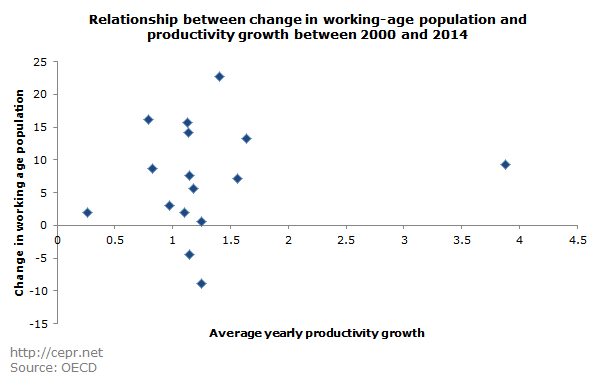December 22, 2016
The International Monetary Fund (IMF) recently released two papers assessing the impact of an aging population on productivity growth, one looks at Europe, the other one at Japan. Their argument is simple: an aging population also means an overall older and less productive workforce.
The IMF’s Japan study supports this finding by showing that prefectures that are aging faster experienced slower economic growth than prefectures with higher population growth. They make the point that the faster aging is to blame for the slower growth; however, this does not take into account that young people tend to move to urban areas where there is higher productivity growth.
If we compare countries rather than regions, this link is no longer apparent. Looking at population and productivity growth for a series of OECD countries, there is no obvious connection between these two measures.
Using OECD data we calculated the change in the working-age population and the average productivity growth for Australia, Belgium, Canada, Denmark, Finland, France, Germany, Italy, Japan, Korea, Norway, Sweden, the UK, and the US.

The figure above illustrates the relationship between the change in the working-age population and productivity growth between 2000 and 2014. There is no clear sign that productivity growth is slower in places with lower population growth.
Between 2000 and 2014, the working-age population shrunk in Germany and Japan, with a decline of 4 and 9 percent respectively. However, productivity growth in both places has been about average. The country with the fastest productivity growth is Korea with an average yearly growth of almost 4 percent. While growth in working age population in Korea has been fairly high, at 9 percent, it is much lower than in Australia (23 percent), in Canada (16 percent), or the U.S (13 percent). Norway had very low productivity growth, despite the high increase in working-age population of 16 percent.
While clearly an aging population and workforce do place certain burdens on society, if it has a negative impact on productivity growth, the effect of aging can clearly be outweighed by other factors.






